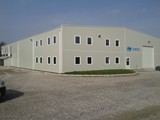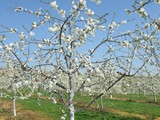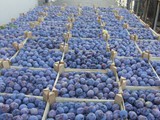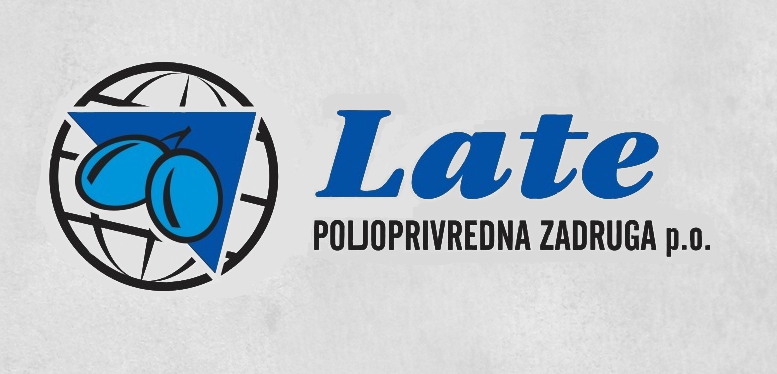


Contact:
Ledenice Donje bb
Gradačac
Bosnia and Herzegovina
Phone. / Fax: +387 35 330 905
Mob.: +387 61 150 900
e-mail:
poljoprivredna.zadruga.late@gmail.com
Plums planting
If the land preparation was pre-made, planting can be done in the fall or early spring. Large number of agrigultural engineers recommend planting to be done in fall, as apples and pears.
Before planting, it is necessary to make preparation of seedlings, that means it is necessary to remove all injured roots. In addition to ameliorative fertilization, it is recommended to fertilize during planting. In this case, the manure or compost is in combined with fertilizers.
When raising crops it is necessary to pay attention that plums have sufficient exposure to sunlight. For this reason it is recommended to route the rows in north-south direction. The distance between rows and in the row depends on the vigor varieties and rootstocks, selected breeding form and breeding system, but for Gradačac area the best distance is 5 m X 3 m.
Planting technique is the same as for apples and pears. Two to three weeks before planting the ground should be leveled and furrowed. The surface then should be measured and marked. In the excavated pits or grooves, an equally developed and healthy seedlings should be planted in a certain row spacing and spacing in the row. The seedling is placed 5 cm from the stake. A layer of loose soil (thickness of 5-8 cm) is placed on the root and then is a good step on it. About 20-30 kg of ripe manure per seedling shouold be placed on this area. In the end, everything should be covered with the ground and watered. Vaccination place should be at least 10 cm above ground level.
Plum tree pruning
Plums are usually pruned in March. By the Požegača specie, excess of internal branches are removed. External branches are usually left on the tree, except if they are dead or broken. With pruning of plum tree we should be moderate, because significant pruning of požegača can effect plum's yield.
It is important to note that the branches in this specie should not be truncated, because it will reduce yield potential. Stenlej, Čačak's fertile i Čačak's beauty are varieties that require a sharper pruning because they have a tendency to displace a large number of buds. Any excess internal branch is removed, and the outer branches are shortened. On older trees that are inadequately cropped usually native elements are located on the periphery of the crown, so it is essential to prevent movement of the vegetation to peak branches or crown by proper pruning. This is achieved by shortening the stronger branches and twigs at the top, beware not to bare the main branches.
Plum grows in mixed fruit branches, long fruiting branches, short fruiting branches spear spines and may bunches. Way of pruning the plum depends also on the type of fruiting branches which gives rise to certain varieties of plums. Požegača, Stenlej, Čačak's beauty i Čačak's fertile grows mainly on short fruiting branches and spines spear which was formed on the older wood. While pruning, we should leave certain number of unfertile branches which will develope in fertile branches.
Pruning usually starts from the top and downwards, by truncating the highest skeletal branch and by leaving one outer branch at the top. Also, all dead, damaged or broken branches, water absorbers and the branches that grow inside the crown should be cut down to the basics. If some branches are more developed and there is a tendency to overpower the secundary or primary braches, they should be truncated. If in the tree canopy there is a gap, then there should be left one water absorbing branch but it must not be too exuberant. From the fruiting branches, the old and degenerate branches are first removed, then thin and overshadowed branches, and in case if there is too many young fruit branches they have to be pruned in order to make the balance between generative and vegetative parts and allow the formation of fruit elements for the coming year.
Rejuvenation is an agro-tehnical measure that is often used in extensive plum-growing. The main objective of this measure is to remove old and worn-out parts of the crown and to encourage regular vegetative increase. Without rejuvenation there is no reconstruction of the skeleton of the crown, there is no formation of new fruiting branches and by that there is no regular yield.
The main indicators that we should approach to rejuvenation of plums are weak peak increment, drying of shoulder branches extensions, stripping the lower parts of the shoulder branches and also if the crown is damaged due to breakage of branches under the weight of fruit, snow, storm, etc.
Rejuvenation is a delicate operation and should be approached with a lot of attention, caution and knowledge. Rejuvenation should not be done at once, it should be done gradually, over the period of 2-3 years.
Under rejuvenation of guide and shoulder branches we should shortened them to suitable branch, which will assume the role of guide and shoulder branches to capture the desired position in space. Intersections that are made should not be greater than 10 cm in diameter, while the cross sections up to 5 cm in diameter heal faster. Larger wound should be smoothen with a sharp knife and protected with spool wax.
The success of rejuvenation depends on the care that is necessary to carry out after this operation. A plum tree and shoulder branches should be protected with plaster from the influence od the sun and frost. This measure is intended to prevent overheating of the tree and vegetation early start and in the same time it is a disinfectant which protects the tree and the shoulder branches of the parasite. Also, plums should be abundantly mucked, protected against diseases and pets and irrigated. Plum rejuvenation is best to be done in January and February.
Plum harvest
Harvest time is determined by intendet use of plums and by degree of maturity. The ripe of fruit for harvesting can be determined in various ways: by separating the fruit from the stem of the branch, by seperating the fruit from the stalk, by change of epidermis color, by change of pip color, by separating pip from the "flesh", by firmness and taste of the fruit, etc.
Determination of harvest time is very important because it directly affects the quality of the fruit, their transporability and storage capability. This applies not only for one day, but to the moment when the harvest begins. The harvest should be efficient and completed in scheduled deadlines. Preferably, harvesting should be carried out in dry and fine weather. If the plum is intended for "fresh" consumption, it should be harvested directly into the packaging. It important to take care about hand hygiene of the pickers, ecpacially with table varieties, and we should be careful not to damage the fruit branches.
The trasport of harvested plums over the unpaved roads, espacially those intended for fresh consumption, should be done carefully. It is recommended not to overfill plum crates and to be carefull during transport of plum for "fresh" use, unlike the plums for processing who goes in divers packaging.
